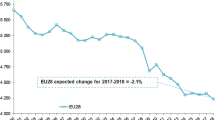Abstract
Tradable black (CO2) and green (renewables) quotas gain in popularity and stringency within climate policies of many OECD countries. The overlapping regulation through both instruments, however, may have important unintended consequences. Based on theoretical analysis we show that a green quota imposed on top of a black quota promotes power production by the dirtiest technologies as compared to a black quota regime only.
Similar content being viewed by others
References
Abrell J., Weigt H. (2008) The interaction of emission trading and renewable energy promotion WP-EGW-05. Dresden University of Technology, Dresden
Amundsen E. S., Mortensen J. B. (2001) The Danish Green Certificate Market: Some simple analytical results. Energy Economics 23: 489–509
Bennear L., Stavins R. (2007) Second-best theory and the use of multiple policy instruments. Environmental and Resource Economics 37: 111–129
Böhringer C., Lange A. (2005) Mission impossible!?—on the harmonization of national allocation plans under the EU emissions trading directive. Journal of Regulatory Economics 27: 51–71
Böhringer, C., & Rosendahl, K. E. (2009). Green serves the dirtiest. On the interaction between black and green quotas, Discussion Papers 581, Statistics Norway, Discussion Papers in Economics V-315-09, Oldenburg University, and CESifo Working Paper No. 2837.
Böhringer C., Koschel H., Moslener U. (2008) Efficiency losses from overlapping regulation of EU carbon emissions. Journal of Regulatory Economics 33: 299–317
European Commission. (2008). Winning the fight against climate change: an EU perspective, Cambridge—UK, 2008, available at: http://www.europe.org.sg/en/pdf2008/Winning%20the%20Fight%20against%20Climate%20Change%20an%20EU%20Perspective.pdf.
Fischer, C. (2006). How can renewable portfolio standards lower electricity prices? RFF Discussion Paper 06-20-REV, Washington, DC: Resources for the Future.
Gonzáflez P., del Rio. (2007) The interaction between emissions trading and renewable electricity support schemes. An overview of the literature. Mitigation and Adaptation Strategies for Global Change 12: 1363–1390
Hahn R. (1986) Trade-offs in designing markets with multiple objectives. Journal of Environmental Economics and Management 13: 1–12
Hogendorn C., Kleindorfer P. R. (2008) The economics of renewable resource credits. In: Bazilian M., Roques F. (eds) Analytical methods for energy diversity and security. Elsevier, London, UK
Morthorst P. E. (2001) Interactions of a tradable green certificate market with a tradable permits market. Energy Policy 29: 345–353
NERA. (2005). Interactions of the EU ETS with Green And White Certificate Schemes, Technical report 17 November 2005, NERA Economic Consulting, London.
Neuhoff, K., Johnston, A., Fouquet, D., Ragwitz, M., & Resch, G. (2008). The proposed new EU renewables directive: an interpretation, Discussion paper April 2008. http://www.electricitypolicy.org.uk/pubs/misc/neuhoff_renewables_directive.pdf.
Rathmann M. (2007) Do support systems for RES-E reduce EU-ETS-driven electricity prices?. Energy Policy 35: 342–349
RGGI. (2008). Regional Greenhouse Gas Initiative—an initiative of the Northeast and Mid-Atlantic States of the U.S. http://www.rggi.org/docs/RGGI_Executive_Summary.pdf.
Sorrell S., Sijm J. (2003) Carbon trading in the policy mix. Oxford Review of Economic Policy 19: 420–437
Tinbergen J. (1952) On the theory of economic policy, Chaps. 4 and 5. North Holland, Amsterdam
VDEW. (2004). Load patterns and utilisation, Lecture notes by Prof. Dr. Winje, VL Energiewirtschaft TU Berlin.
WCI. (2008). Western Climate Initiative, http://www.westernclimateinitiative.org/.
Author information
Authors and Affiliations
Corresponding author
Rights and permissions
About this article
Cite this article
Böhringer, C., Rosendahl, K.E. Green promotes the dirtiest: on the interaction between black and green quotas in energy markets. J Regul Econ 37, 316–325 (2010). https://doi.org/10.1007/s11149-010-9116-1
Received:
Accepted:
Published:
Issue Date:
DOI: https://doi.org/10.1007/s11149-010-9116-1




